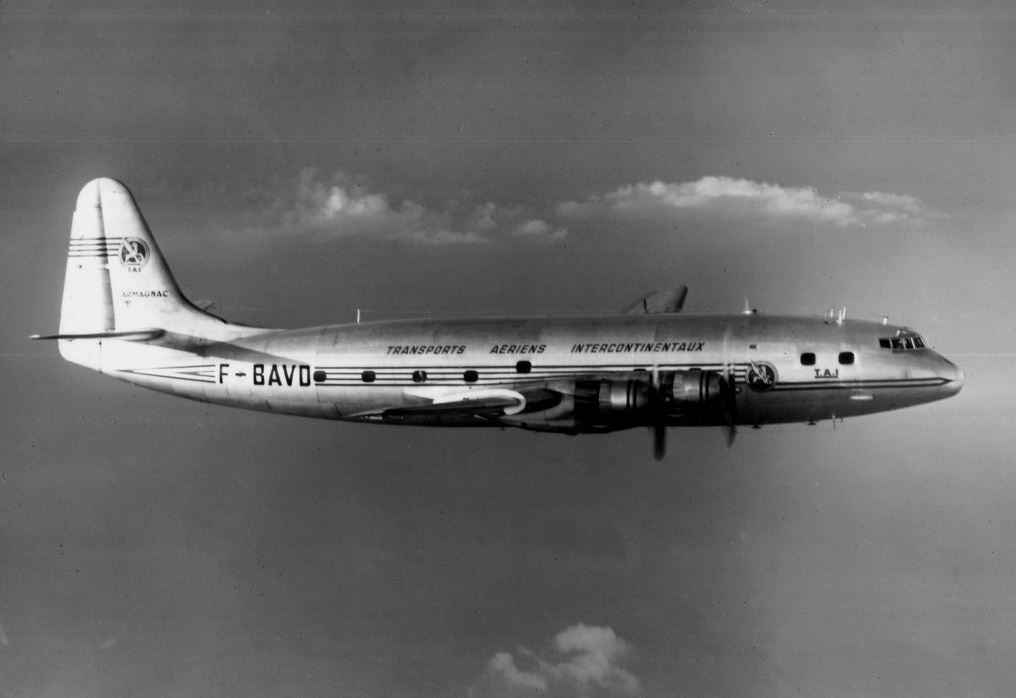The Sud-Est SE 2010 Armagnac was a French airliner that first flew on 2 April 1949. It was powered by four Pratt & Whitney R-4360-B13 Wasp Major engines and was designed for long haul transatlantic flights, with a range of up to 5,120 kilometres (3,180 miles).
What made this aircraft stand out was its size. It featured a wingspan of 48.95 metres, slightly more than that of a Boeing 767, and had a near circular cabin which was 4.7m (15 feet) in width and height. Quite remarkable!
SE 2010 Armagnac Video
Following on from the last video about the Convair 240, 340 and 440, this week we head over to France for a look at the S.E. 2010 Armagnac. This video hails from 1952 and runs for just under one minute.
While it is totally silent, it packs a lot into its running time. You see the aircraft on the ground, taking off, some air to air shots, the cabin, cockpit and on board service.
Why Was It So Large?
As originally designed, it was intended to seat 60 passengers and provided sleeping berths for all. These were arranged in three tiers, necessitating the extended cabin height.
In Airline Service
Transports Aériens Intercontinentaux or TAI for short, took delivery of four SE 2010 Armagnac’s in late 1952. They operated them for eight months but found them unprofitable and removed them from service.
The Melbourne Olympics
Two SAGETA Armagnac’s transported the French Olympic team and officials to Australia in 1956 for the Melbourne Olympics. When one aircraft was ferried to Mangalore, an arriving TAA pilot was asked to report sighting and passing the Armagnac and replied, “If it’s that block of flats below us, we’re passing it now!”
Overall Thoughts
Just nine SE 2010 Armagnacs were built, and most had been broken up by 1955. Eventually the final aircraft was retired in 1959. The last example was scrapped in Bordeaux in 1975 so it is not possible to see one any longer.
It never lived up to its original design, was underpowered and lacked the range needed for its mission, but even so it must have been something to see at the time. Another also-ran in the world of aviation, but still worth remembering.
Did you ever fly on board a Sud-Est SE 2010 Armagnac? What did you think of the video? Thank you for reading and if you have any comments or questions, please leave them below.
Enjoying the series? Check out the index to all the “Does Anyone Remember…” articles.
Flight reviews your thing? Mine are all indexed here.
Follow me on Facebook, Twitter and Instagram.
Featured image by USN via Wikimedia Commons.
Brochure and cross section via armagnac2010 in The Giants That Failed thread on airliners.net.
Cabin interior and painting via AviaDejaVu, from Aeroplane Monthly Nov 1993, J. Stroud.

















Interesting backstory on a little-known airliner. The every-other-row gets-get-a-window arrangement would have been a real turn off for me (unless I had the window!) but the aircraft does look spacious enough, especially for the time. Unique for sure.
First thing I noticed on that cabin picture were the seats with no window. Obviously it was meant to have compartments like a train, which is why it’s like that, but even so, not for me either. Certainly an aircraft I’d never heard of until a week ago!